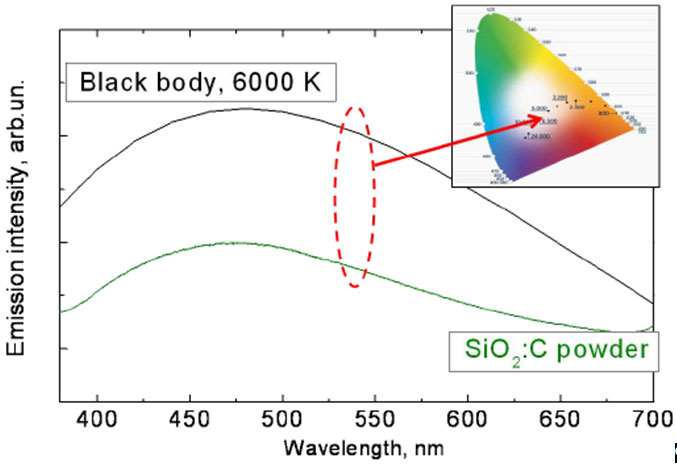Theoretical and experimental investigations of electronic, magnetic and optical properties of nanosized carbon-containing materials
Luminophores of “white light” are an important part of white-light-emitting diodes, and the main part of these diodes consists from UV light sources (usually an InGaN based light-emitting structure) and a luminophor transforming UV into a broad spectrum of white light. To date, rare earth or heavy metals are the main components of luminophors leading to its recycling complexity and increase in manufacturing costs. Moreover, the spectral characteristics of the modern commercial luminophors do not correspond to the spectral characteristics of the sunlight. The production of the luminophors with light emission of high efficiency is a task of current importance; however, without the knowledge of physical mechanisms of light emission, it is impossible to obtain an effective luminophor with an appropriate emitting spectrum. At the same time, the production of high-speed and compact photodetectors is also an actual and perspective task that is connected with the light emission of these materials and properties of ohmic contacts to them.
In current work, the technology methods of synthesis for а-SiO 2 :C/Si and а SiOC:H/Si thin films as well for SiO 2 :C and Al 2 O 3 :C nanopowders with different thermal treatment were developed and as a result the experimental samples were obtained. The relationship between the growth of isolated carbon (C) content and the rise of broad photoluminescence (PL) band intensity in а-SiOC:H films and а- SiOC:H nanopowders has been established. It was proved that PL emission arises from C nanodots distributed over the SiO 2 :C surface. The increase in PL intensity in Al 2 O 3 :C nanopowders was found to be caused by the formation of SiO 2 :C on the Al 2 O 3 particle surface. The charge carrier transport in graphene layers deposited on SiO 2 was studied. It was found that the charge carrier distribution at high temperatures in graphene is determined by phonon component. A working formula for the capacity of contact metal-graphene film was obtained. A simple method for synthesis of graphene flakes from solid precursor has been developed. The new C structures in the form of graphene bubbles, multi-layer C tubes and “stars” formed after gamma-irradiation were observed for the first time. The significant decrease of specific resistance of graphene oxide by thermal annealing at low temperatures was revealed and explained. The kinetic Monte-Carlo method for investigation of growth and evaporation processes nanoparticles to/from nanotubes as well as for the study of the nanorods non-stability leading to their transformation to ordered nanocluster chains was developed.

| Вложение | Размер |
|---|---|
| 170.25 КБ |




